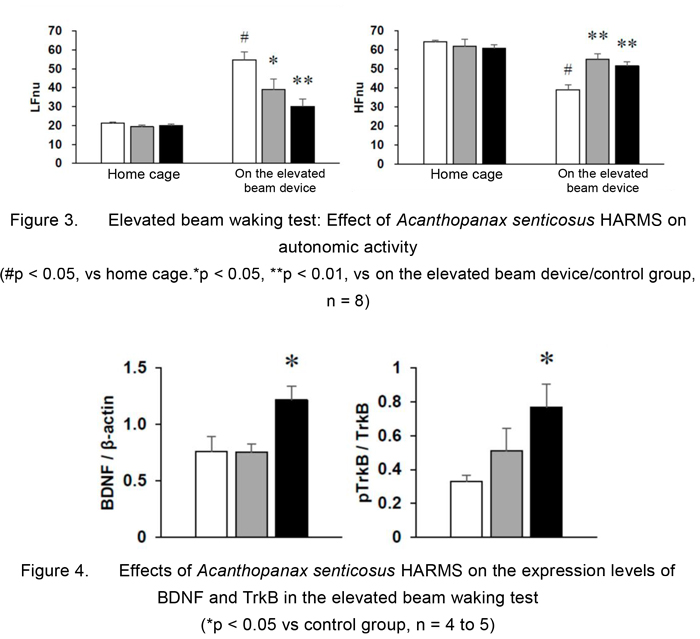- TOP
- List of reports
- Acanthopanax senticosus HARMS exerts its anxiolytic effects via regulation of autonomic function
and activation of hippocampal brain derived neurotrophic factor signaling
Acanthopanax senticosus HARMS exerts its anxiolytic effects via regulation of autonomic function and activation of hippocampal brain derived neurotrophic factor signaling
【Scientific information】
Research and Development Department, Sun Chlorella Corporation
Acanthopanax senticosus HARMS exerts its anxiolytic effects via regulation of autonomic function and activation of hippocampal brain derived neurotrophic factor signaling
Published in the academic journal “Molecules” (2017 Impact factor = 3.098)
- Objective
- There have been several reports of the anxiolytic and anti-stress effects of Acanthopanax senticosus HARMS, but few reports studied the mechanism of these effects and the anxiolytic effects of Acanthopanax senticosus HARMS were therefore evaluated in detail in this study.
- Methods
- 1) Novel environment test
Animals are known to take longer time to begin eating due to anxiety when they are placed in novel environment. Male SD rats were transferred from cages where they were originally housed (home cages) to different cages (novel cages) that were covered with a blackout curtain on the sides and bottom, and their latency to eat in novel cages was measured and autonomic function (activity of sympathetic and parasympathetic nerves) was also measured with a bioelectric potential transmitter attached to rats. Acanthopanax senticosus HARMS extracts was mixed with diet and given for 1 week prior to testing.
2) Elevated beam waking test
If rats are placed on the open arm without walls of an elevated beam device (190 cm height x 8 cm width x 140 cm length; closed arm placed at one end [safe room with 3 sides covered with walls]), they immediately move to the safe room due to anxiety or fear. Male SD rats were placed on the open arm of the elevated beam device to measure their time stayed on the open arm and autonomic function until entering the safe closed arm. In addition, the expression levels of hippocampal brain-derived neurotrophic factor (BDNF) and high-affinity BDNF receptor TrkB were measured after the elevated beam waking test. Acanthopanax senticosus HARMS extracts was mixed with diet and given for 1 week prior to testing.
- Results
- 1)
Novel environment test
In the control group, their time to
start eating was markedly prolonged by transferr ing from
their home cages to n ovel cages, whereas the latency to eat was significantly shortened in
the groups given diet containing 1% and 5% Acanthopanax senticosus HARMS compared
with the control group although it was longer than that when they were kept in home cages
(Figure 1). In the group treated with Acanthopanax senticosus HARMS, sympathetic activity was significantly decreased and parasympathetic activity was significantly increased in novel cage compared with the control group (Figure 1).
2)Elevated beam waking test
The time stayed on the open arm was significantly prolonged in the groups treated with Acanthopanax senticosus HARMS compared with the control group (Figure 2). In the control group, sympathetic activity was significantly increased and parasympathetic activity was sig nificantly decreased when they were placed on the elevated beam device compared with when they were kept in home cages , whereas these changes were significantly reduced in the groups treated with Acanthopanax senticosus HARMS (Figure 3). In addition, the expression levels of hippocampal BDNF and TrkB were increased in the groups treated with Acanthopanax senticosus HARMS compared with the control group (Figure 4).
Based on these results, the anxiolytic effects of Acanthop anax senticosus HARMS suggest ed to exert through regulation of autonomic function and activation of hippocampal BDNF signaling.


Terminology
- *1:LFnu
- A parameter of sympathetic activity determined by frequency analysis of electrocardiogram (ECG). The value increases due to stress such as anxiety and fear.
- *: HFnu
- A parameter of parasympathetic activity determined by frequency analysis of ECG.
The value decreases due to stress such as anxiety and fear.
- *: BDNF
- B rain derived neurotrophic factor (B DNF) A secretory protein that acts in the development, growth, maintenance, and repair of neurons and also plays important roles in learning, memory, emotion, etc. Recently, it has been confirmed that BDNF is reduced in the brain, mainly hippocampus and c erebral cortex, in patients with depression, Alzheimer's disease, anxiety states, etc.
- *: TrkB
- High affinity BDNF receptor; BDNF exerts various physiological functions through TrkB.
Details
- Journal name:
- Molecules 24(1), 2019
- Title:
- Anxiolytic Effects of Acanthopanax senticosus HARMS Occur via Regulation
of Autonomic Function and Activate Hippocampal BDNF TrkB Signaling - Authors:
- Shouhei Miyazaki1, Hirotaka Oikawa2, Hideo Takekoshi3, Masako Hoshizaki3,
Masato Ogata4, and Takahiko Fuji kawa1,2,4 - Affiliation:
- 1Laboratory of Molecular Prophylaxis and Pharmacology, Graduate School of
Pharmaceutical Sciences, Suzuka University of Medical Science, 2Faculty of
Pharmaceutical Sciences, Suzuka University of Medical science, 3Sun Chlorella
Corp.,
4Mie University Graduate School of Medicine
doi:https://doi.org/10.3390/molecules24010132





